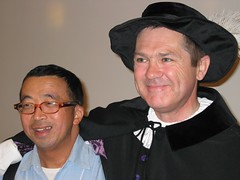The plenary lecture of day 3 (Wednesday) was Marc Moyon’s “Practical Geometries in Islamic Countries: the Example of the Division of Plane Figures”. Again, this is so far from my tiny area(s?) of competence that I will write little about it – in an attempt to make no errors (except errors of omission, of course). However, one main point is that mathematicians in these countries knew how to divide plane figures in different ways (for instance to divide three equal squares so that they could be put together to form one larger square). Craftsmen also knew how to do this – in ways that were not mathematically correct, but that were visually correct. Part of this lecture was about the relationship between the two.


Michael N. Fried asking Marc Moyon a question. Andreas and Uffe are listening.
Sunwook Hwaan presented the plans for the HPM 2012 conference which will take place in Daewoon, an hour or two from Seoul (where the ICME conference will be). The information given in such a presentation is always less important than just assuring the audience that the planning process is going smoothly, and we certainly got a good impression from this presentation.
Then there was a panel discussion on “The history of mathematics in school textbooks”. The panelists were Anne Boyé, Adriano Dematté, Ewa Lakoma and Costantinos (Costas) Tzanakis. Part of the discussion confirmed that the situations in different countries are quite similar in many respects. I started my HPM “career” in 2000 by describing how history of mathematics is treated in Norwegian textbooks (after the 1997 reform of the curriculum). There were lots of errors, biographical details with no real significance and meaningless tasks for the children to do.

In this discussion, Dematté noted that there is too much “reading about” and too little “doing mathematics” when history of mathematics is in the textbooks. (According to publishers and teachers, history of mathematics is for reading.) Ewa Lakoma noted that history of mathematics tends to become a “set of curious details” instead of a source of stimulating contexts. Costas (quoting someone, I’m sorry I missed whom) asked if the history of mathematics in the textbooks makes the students spectators. Boyé gave the example of a task from a textbook: “Archimedes is a famous ancient greek mathematician. He was born in Syracuse in 287 B. C. and died in 212 B. C. How many years did he live?” This sort of meaningless exercise was also in the 1997 material of Norwegian textbooks.
This was a very well prepared panel, in that the main contributions of the panel were published in advance and people were asked to prepare comments. I had prepared a comment on a section on different ways of including history of mathematics in textbooks. I find the question a bit strange, as if you have the history of mathematics in your left hand and your textbook in your right hand and you want to include some of the history in the textbook that already exists. Contrary to this, one may say that as history of mathematics is an integral part of mathematics, history of mathematics should be a natural, explicit and integral part of the textbooks. I gave the example of textbooks on literature: I do not think that textbook writers on literature first write about the literature, for instance “Romeo and Juliet”, and then sit down and wonder “Maybe we should mention Shakespeare? How could we include the history of literature in this literature textbook?” But, on the other hand, a textbook has to have an audience; otherwise it will not be very useful. To write a textbook that is brilliant but that no one will ever read is a futile exercise.
That, surprisingly, was the end of the third day. After getting used to working till at least 8 at night, it was welcome to finish before lunch – if only to get time for some meetings that would be difficult to arrange otherwise. In the afternoon, there were sightseeings. I very much doubt that you will want the details of that. And then there was a reception in the “Rathauskeller” (town hall cellar), which was a splendid place.























